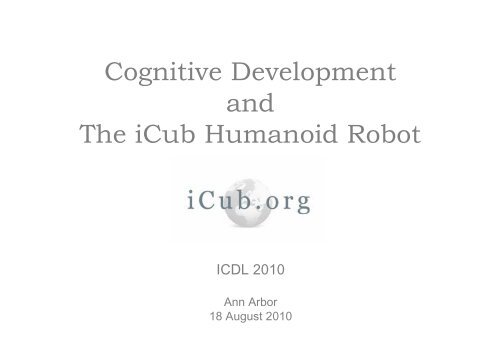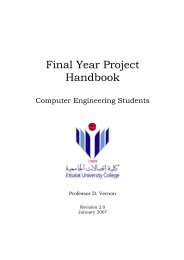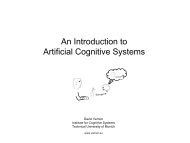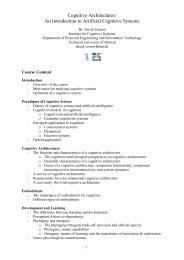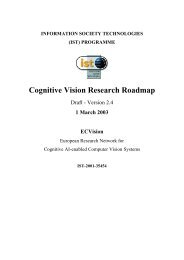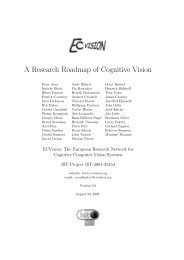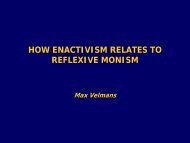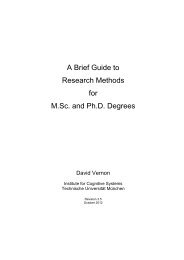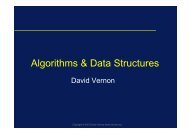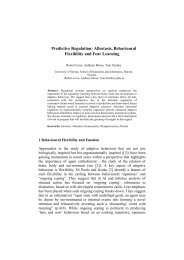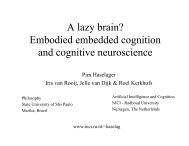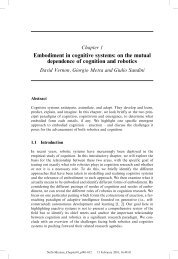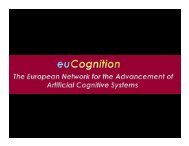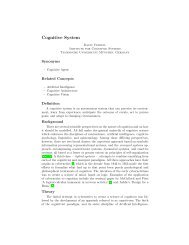slides - David Vernon
slides - David Vernon
slides - David Vernon
You also want an ePaper? Increase the reach of your titles
YUMPU automatically turns print PDFs into web optimized ePapers that Google loves.
Cognitive Development<br />
and<br />
The iCub Humanoid Robot<br />
ICDL 2010<br />
Ann Arbor<br />
18 August 2010
Funded by The European Commission, Project IST-004370, RobotCub,<br />
under Strategic Objective 2.3.2.4: Cognitive Systems
Giulio Sandini, IIT & U. Genoa<br />
Giorgio Metta, IIT & U. Genoa<br />
<strong>David</strong> <strong>Vernon</strong>, IIT & U. Genoa<br />
Lorenzo Natale, IIT & U. Genoa<br />
Francesco Nori, IIT & U. Genoa<br />
Paul Fitzpatrick, IIT & U. Genoa<br />
Francesco Orabona, IIT & U. Genoa<br />
Matteo Brunettini, IIT & U. Genoa<br />
Alessandro Scalzo, IIT<br />
Marco Maggiali, IIT<br />
Marco Randazzo IIT<br />
Roberto Puddu, IIT<br />
Gabriele Tabbita, IIT<br />
Walter Fancellu, IIT<br />
Bruno Bonino, IIT<br />
Fabrizio Larosa, IIT<br />
Claudio Lorini, IIT<br />
Luciano Pittera, IIT<br />
<strong>David</strong>e Dellepiane, IIT<br />
Mattia Salvi, IIT<br />
Luca Rivano, IIT<br />
Ravinder Dahiya, IIT<br />
Alberto Parmiggiani, IIT<br />
Matteo Fumagalli, IIT<br />
Alexander Schmitz, IIT<br />
Diego Torazza, IIT<br />
Nikos Tsagarakis, IIT & U. Sheffield<br />
Darwin Caldwell, IIT & U. Sheffield<br />
Francesco Becchi, TeleRobot<br />
Paolo Pino, TeleRobot<br />
Giulio Maggiolo, TeleRobot<br />
Gabriele Careddu TeleRobot<br />
John Gray, U. Sheffield<br />
Samia Nefti, U. Sheffield<br />
Rolf Pfeifer, U. Zurich<br />
Harold Martinez, U. Zurich<br />
Gabriel Gomez, U. Zurich<br />
Alexandre Schmitz, U. Zurich<br />
Yvonne Gustain, U. Zurich<br />
Jonas Ruesch, U. Zurich<br />
Kerstin Dautenhahn, U. Hertfordshire<br />
Chrystopher L. Nehaniv, U. Hertfordshire<br />
Hatice Kose-Bagci, U. Hertfordshire<br />
Frank Broz, U. Hertfordshire<br />
Naeem Assif Mirza, U. Hertfordshire<br />
Dorothée François, U. Hertfordshire<br />
Lars Olsson, U. Hertfordshire<br />
Qiming Shen, U. Hertfordshire<br />
Cecilia Laschi, SSSA<br />
Paolo Dario, SSSA<br />
Fernando Gamarra, SSSA<br />
<strong>David</strong>e Zambrano, SSSA<br />
Egidio Falotico, SSSA<br />
Maria Chiara Carrozza, SSSA<br />
Giovanni Stellin, SSSA<br />
Giovanni Cappiello, SSSA<br />
Aude Billard, EPFL<br />
Auke Ijspeert, EPFL<br />
Sarah Degallier, EPFL<br />
Ludovic Righetti, EPFL<br />
S. Gay, EPFL<br />
José Santos-Victor, IST<br />
Alexandre Bernardino, IST<br />
Ricardo Beira, IST<br />
Bruno Damas, IST<br />
Jonas Hornstein, IST<br />
Luís Vargas, IST<br />
Ricardo Nunes, IST<br />
Hugo Alves, IST<br />
Nuno Conraria, IST<br />
Julio Gomes, IST<br />
Matteo Tajana, IST<br />
Giovanni Saponnaro, IST<br />
Christian Wressengger, IST<br />
Dario Figueira, IST<br />
Rodrugo Ventura, IST<br />
Miguel Praça, IST<br />
Jonas Ruesch, IST<br />
Luís Montesano, IST<br />
Manuel Lopes, IST<br />
Luciano Fadiga, U. Ferrara<br />
Laila Craighero, U. Ferrara<br />
Andrey Olyniyck, U. Ferrara<br />
Livio Finos, U. Ferrara<br />
Giovanni Ottoboni, U. Ferrara<br />
Claes von Hofsten, U. Uppsala<br />
Kerstin Rosander, U. Uppsala<br />
Olga Kochukova, U. Uppsala<br />
Helena Gronqvist, U. Uppsala
Giulio Sandini<br />
Giorgio Metta<br />
Italian Institute of Technology &<br />
University of Genova<br />
Kerstin Dautenhahn<br />
Chrystopher Nehaniv<br />
University of Hertfordshire<br />
Claes von Hofsten<br />
University of Uppsala<br />
Darwin Caldwell<br />
Nikos Tsagerakis<br />
University of Salford & IIT<br />
Luciano Fadiga<br />
University of Ferrara<br />
Jose Santos-Victor<br />
Alexandre Bernardino<br />
Instituto Superior Tecnico, Lisbon<br />
Rolf Pfeiffer<br />
University of Zurich<br />
Aude Billard<br />
Auke Ijspeert<br />
Ecole Polytechnique Federale de Lausanne<br />
Paolo Dario<br />
Cecilia Laschi<br />
Scuola Superiore Sant’Anna, Pisa<br />
Francesco Becchi<br />
TeleRobot S.r.l.
Rodney Brooks<br />
MIT<br />
Gordon Cheng<br />
Technische Universität München<br />
Yasuo Kuniyoshi<br />
University of Tokyo<br />
Juergen Konczak<br />
University of Minnesota<br />
Hideki Kozima<br />
NICT (CRL)
Head: 6 DoF<br />
Hand 9 DoF<br />
Arm 7 DoF<br />
Waist 3 DoF<br />
Leg 6 DoF
Head Design<br />
(IST)
Face/Cover Design<br />
(IST)
Facial Expressions<br />
(IST)
Reaching and Grasping<br />
(U. Genoa, IIT, IST)
Reaching and Grasping<br />
(U. Genoa, IIT, IST)
iCub production<br />
15 iCubs completed and 5 more in production
Nature, Vol 460<br />
August 2009<br />
News Feature
Wiki<br />
Software<br />
Hardware<br />
Drawings
Enaction<br />
Developmental<br />
Psychology<br />
Phylogeny<br />
Ontogeny<br />
Neurophysiology<br />
Computational<br />
Modelling
Enaction<br />
Developmental<br />
Psychology<br />
Phylogeny<br />
Ontogeny<br />
Neurophysiology<br />
Computational<br />
Modelling
Enaction<br />
Enactive Cognitive Science
Cognition
Mind as Motion, Port & Van Gelder
Cognitivism<br />
Cognitive Systems<br />
Functionalist & Dualist<br />
Mechanisms are independent<br />
of the instantiation<br />
Emergent, Embodied, & Enactive<br />
Embodiment plays a constitutive<br />
role in the process of cognition
Cognition: the process by which an autonomous selfgoverning<br />
agent acts effectively in the world in which<br />
it is embedded<br />
Dual purpose:<br />
1. Expand the space of possible action<br />
2. Extend anticipatory capabilities<br />
Development plays an essential role in the realization<br />
of cognitive capabilities
Living in the future:<br />
breaking the ‘here-and-now barrier’<br />
Bond of Union<br />
M. C. Escher, 1956
Creating your own knowledge:<br />
breaking the ‘prior knowledge barrier’<br />
z<br />
Bond of Union<br />
M. C. Escher, 1956
Drinking from the Fire-hose of Experience<br />
z<br />
Bond of Union<br />
M. C. Escher, 1956<br />
(Kuipers 2005)
Enaction<br />
Dull but important part ….<br />
z
Enaction<br />
• Five key elements to enactive systems<br />
– Autonomy<br />
– Embodiment<br />
– Emergence<br />
– Experience<br />
– Sense-making
Enaction<br />
• Autonomy<br />
– Self-maintenance<br />
– Homeostasis<br />
– Not controlled by outside agencies<br />
– Stands apart from its environment
Enaction<br />
• Embodiment<br />
– Exists as a physical entity<br />
– Directly interacts with its environment<br />
• Structural coupling<br />
• Mutual perturbation<br />
– Constitutive part of the cognitive process
Enaction<br />
• Emergence<br />
– Cognitive behaviour arises from dynamic interplay<br />
between component parts<br />
– Internal dynamics<br />
• Maintains autonomy<br />
• Condition the system’s experiences through their embodiment<br />
in a specific structure
Enaction<br />
• Experience<br />
– History of interaction with the world<br />
– Interactions don’t control<br />
– Interaction do trigger changes in system state<br />
– Changes are structurally-determined<br />
• Phylogeny<br />
• Structural coupling
Enaction<br />
• Sense-making<br />
– Knowledge is generated by the system itself<br />
– Captures some regularity or lawfulness in the interactions<br />
– The ‘sense’ is dependent on the way interaction can take place<br />
• Perception & Action<br />
– Modify its own state (CNS) to enhance<br />
• Predictive capacity<br />
• Action capabilities<br />
– Development: generative autonomous self-modification
Embodiment<br />
Knowledge & Meaning<br />
(inter-agent epistemology)<br />
Development
Types of Embodiment<br />
Why Humanoid Robotics is Special<br />
Historical Embodiment<br />
Organismic<br />
Embodiment<br />
Organismoid<br />
Embodiment<br />
Physical Embodiment<br />
Shared epistemology ⇒<br />
compatible embodiment<br />
Structural Coupling<br />
From: T. Ziemke, 2003
The problem of disparate embodiment & interaction histories
The problem of disparate embodiment & interaction histories
Meaning emerges through shared consensual<br />
experience mediated by interaction<br />
Bond of Union<br />
M. C. Escher, 1956<br />
Bond of Union<br />
M. C. Escher, 1956
Development<br />
Progressive ontogenetic acquisition of anticipatory<br />
capabilities<br />
– Cognition cannot short-circuit ontogeny<br />
– Necessarily the product of a process of embodied development<br />
– Initially dealing with immediate events<br />
t<br />
– Increasingly acquiring a predictive capability<br />
t<br />
Cognition and perception are functionally-dependent<br />
on the richness of the action interface
Co-determination / Structural Coupling<br />
Automony preserving mutual interaction<br />
Perturbation of the system is only effected by the environment<br />
[Note: this ideogram and similar ones to follow were introduced in Maturana and Varela 1987]
Cognitive system: operationally-closed system with a nervous system<br />
Nervous system facilitates a highly-plastic mapping between<br />
sensor and motor surfaces<br />
Perturbation by both environment and system (of receptors & NS)
t<br />
t<br />
Anticipation / Planning / Deliberation / Prediction
INTERACTION<br />
A shared activity in which the actions of each agent<br />
Influence the actions of the other agents in the same interaction<br />
Resulting in a mutually-constructed pattern of shared behaviour<br />
[Ogden et al.]
COGNITION & SENSE-MAKING<br />
Is a process whereby the issues that are important<br />
for the continued existence of the cognitive entity<br />
are brought forth: co-determined by the entity as it interacts<br />
with the environment in which it is embedded
THE SPACE OF PERCEPTUAL POSSIBILITIES<br />
Is predicated not on an objective environment,<br />
but on the space of possible actions<br />
that the system can engage in whilst still<br />
maintaining the consistency of its coupling with the environment
Enactive<br />
Systems<br />
Self-<br />
Organization<br />
Embodiment<br />
Codetermination<br />
Codevelopment<br />
Phylogeny<br />
Ontogeny<br />
Humanoid<br />
Cognitive<br />
Development<br />
Increasing complexity<br />
in action space<br />
Increasing degree<br />
of Prospection
Embodied development is crucial<br />
to the achievement of Cognition<br />
You can’t short-cut ontogenesis<br />
&<br />
You need the right phylogeny to make ontogenesis<br />
possible<br />
You need a humanoid embodiment to achieve cognition<br />
compatible with human understanding
Enaction<br />
Developmental<br />
Psychology<br />
Phylogeny<br />
Ontogeny<br />
Neurophysiology<br />
Computational<br />
Modelling
Developmental Psychology<br />
&<br />
Neurophysiosology
Smooth Pursuit<br />
(U. Uppsala, IST, SSSA)<br />
Perception and anticipation of the upcoming motion<br />
4‐week‐old<br />
9‐week‐old
Smooth Pursuit<br />
(U. Uppsala, IST)<br />
“Uppsala drum” – where we can rotate the base and/or the target<br />
Manuel Lopes, Alexandre Bernardino, José Santos-<br />
Victor, Claes von Hofsten and Kerstin Rosander.<br />
Biomimetic Eye-Neck Coordination. IEEE -<br />
International Conference on Development and<br />
Learning, Shanghai, China, 2009.
Predictive tracking with<br />
temporarily-occluded objects<br />
(U. Uppsala, U. Zürich, SSSA)<br />
4-month-old children move gaze ahead of time to the<br />
place where they expect the object to appear<br />
9‐week‐old lag= 740 ms<br />
17‐week‐old lag = 15 ms
Smooth Pursuit<br />
“Infant” Gaze (U. Uppsala & IST)
Development in Context:<br />
“Drinking from the Fire-hose of Experience”<br />
The importance of attention
Attention<br />
• Infant Gaze (U. Uppsala)
Attention<br />
• Infant Gaze (U. Uppsala)
Attention<br />
Multi-Modal Bottom-Up Attention System (IST & UZH)<br />
Salience<br />
Egocentric<br />
flicker<br />
faces<br />
skin<br />
Multimodal Saliency-Based Bottom-Up Attention A Framework for the Humanoid<br />
Robot iCub, Jonas Ruesch, et al. ICRA 2008.
Attention<br />
• Top-down (IST)<br />
• Representation and detection familiar objects<br />
• Learning triggered by depth (proximity based) segmentation<br />
From Pixels to Objects: Enabling a spatial model for humanoid social robots. Dario<br />
Figueira, et al. ICRA’09
Salience-based Attention<br />
(IST & UZH)
Salience-based Attention<br />
(IST & UZH)
Reaching<br />
(U. Uppsala)
Reaching<br />
(U. Genoa, IIT)
Crawling<br />
Kinematic studies of crawling children as they crawled, went from sitting to<br />
crawling, and crawling to sitting (U. Uppsala, EPFL)<br />
Crawling to sitting
Crawling<br />
Kinematic studies of crawling children as they crawled, went from sitting to<br />
crawling, and crawling to sitting (U. Uppsala, EPFL)<br />
Crawling with one hand occupied
Crawling<br />
Empirical Studies! (U. Ferrara)<br />
Demonstration by Luciano Fadiga
Crawling<br />
Kinematic studies of crawling children as they crawled, went from sitting to<br />
crawling, and crawling to sitting (U. Uppsala, EPFL)
(U. Uppsala, EPFL)
Enaction<br />
Developmental<br />
Psychology<br />
Phylogeny<br />
Ontogeny<br />
Neurophysiology<br />
Computational<br />
Modelling
Computational<br />
Modelling
Review of 20 cognitive architectures<br />
7 criteria:<br />
Embodiment<br />
Perception<br />
Action<br />
Anticipation<br />
Adaptation<br />
Motivation<br />
Autonomy
COGNITION<br />
Cognitivist<br />
Systems<br />
Hybrid<br />
Systems<br />
Emergent<br />
Systems<br />
Connectionist<br />
Approaches<br />
Dynamical<br />
Approaches<br />
Enactive<br />
Approaches
Each with own<br />
limited encodings<br />
Network of<br />
cooperating/competing<br />
circuits<br />
Learning: to tune<br />
phylogenetic skills<br />
Development:<br />
change system dynamics<br />
new action spaces<br />
Self-modification<br />
Model Generation<br />
Cognitive Architecture<br />
Robot Phylogeny<br />
Novel regularities in the world<br />
Exploratory motives<br />
Potential of own actions<br />
agent interaction:<br />
mutually-constructed<br />
patterns of behaviour<br />
Social motives<br />
Supervised<br />
Unsupervised<br />
Reinforcement<br />
Moderate<br />
actual behaviour<br />
Learning<br />
Mechanism to rehearse<br />
hypothetical scenarios<br />
Action-Perception<br />
Couplings<br />
Embodiment
Key Issue:<br />
Development<br />
Learning: to tune<br />
phylogenetic skills<br />
Development:<br />
change system dynamics<br />
new action spaces<br />
Self-modification<br />
– Improve the predictive performance<br />
– Increase the space of viable actions
Key Issue:<br />
Internal Simulation<br />
Three purposes of internal simulation:<br />
1. Prediction: future events<br />
Moderate<br />
actual behaviour<br />
Mechanism to rehearse<br />
hypothetical scenarios<br />
2. Reconstruction: explaining observed events<br />
(imagining a causal chain leading to that event)<br />
3. Imagination: internal simulation as a way of imagining<br />
new ideas
Key Issue:<br />
Exogenous and Endogenous<br />
Exogenous: curiosity<br />
Sensori-motor learning<br />
Novel regularities in the world<br />
Potential of own actions<br />
Exploratory motives<br />
Endogenous: experimentation<br />
Experience-based generative development & operation
iCub<br />
Cognitive Architecture
Multiple YARP processes<br />
each implementing a component<br />
of the iCub Cognitive Architecture<br />
Cognitive<br />
Architecture<br />
YARP middleware:<br />
Transparent support for abstract<br />
process distribution and<br />
inter-process message passing<br />
Software<br />
Architecture<br />
DSP<br />
PC104<br />
Hub<br />
Gbit ethernet<br />
DSP DSP DSP<br />
Sensors & Actuators<br />
iCub<br />
Embedded<br />
Systems
Procedural<br />
Memory<br />
Affective<br />
State<br />
Action<br />
Selection<br />
Episodic<br />
Memory<br />
Locomotion<br />
Attention<br />
Selection<br />
Control<br />
Gaze<br />
iCub<br />
Interface<br />
Egosphere<br />
Reach<br />
& Grasp<br />
A Priori<br />
Feature<br />
Values<br />
Exogenous<br />
Salience<br />
Endogenous<br />
Salience<br />
Vergence<br />
Aural, visual, and proprioceptive sensory data
Procedural<br />
Memory<br />
Affective<br />
State<br />
Action<br />
Selection<br />
Episodic<br />
Memory<br />
Locomotion<br />
Attention<br />
Selection<br />
Control<br />
Gaze<br />
iCub<br />
Interface<br />
A Priori<br />
Feature<br />
Values<br />
Egosphere<br />
Reach<br />
& Grasp<br />
Gaze Control<br />
(IST, SSSA, U. Uppsala)<br />
Exogenous<br />
Salience<br />
Endogenous<br />
Salience<br />
Vergence<br />
Aural, visual, and proprioceptive sensory data
Procedural<br />
Memory<br />
Affective<br />
State<br />
Action<br />
Selection<br />
Episodic<br />
Memory<br />
Reach<br />
Attention<br />
& Grasp<br />
Selection<br />
(U. Genoa, IIT, IST)<br />
Egosphere<br />
Control<br />
Gaze<br />
Locomotion<br />
Reach<br />
& Grasp<br />
iCub<br />
Interface<br />
A Priori<br />
Feature<br />
Values<br />
Exogenous<br />
Salience<br />
Endogenous<br />
Salience<br />
Vergence<br />
Aural, visual, and proprioceptive sensory data
Procedural<br />
Memory<br />
Affective<br />
State<br />
Action<br />
Selection<br />
Episodic<br />
Memory<br />
Locomotion<br />
Attention<br />
Selection<br />
Egosphere<br />
Crawling<br />
(EPFL)<br />
Control<br />
Gaze<br />
Reach<br />
& Grasp<br />
iCub<br />
Interface<br />
A Priori<br />
Feature<br />
Values<br />
Exogenous<br />
Salience<br />
Endogenous<br />
Salience<br />
Vergence<br />
Aural, visual, and proprioceptive sensory data
Attention Sub-system<br />
(IST)<br />
Procedural<br />
Memory<br />
Affective<br />
State<br />
Action<br />
Selection<br />
Episodic<br />
Memory<br />
Locomotion<br />
Attention<br />
Selection<br />
Control<br />
Gaze<br />
iCub<br />
Interface<br />
Egosphere<br />
Reach<br />
& Grasp<br />
A Priori<br />
Feature<br />
Values<br />
Exogenous<br />
Salience<br />
Endogenous<br />
Salience<br />
Vergence<br />
Aural, visual, and proprioceptive sensory data
Procedural<br />
Memory<br />
Affective<br />
State<br />
Action<br />
Selection<br />
Episodic<br />
Memory<br />
Locomotion<br />
Attention<br />
Selection<br />
Control<br />
Gaze<br />
iCub<br />
Interface<br />
Egosphere<br />
Reach<br />
& Grasp<br />
A Priori<br />
Feature<br />
Values<br />
Exogenous<br />
Salience<br />
Endogenous<br />
Salience<br />
Vergence<br />
Aural, visual, and proprioceptive sensory data
P<br />
A<br />
Procedural<br />
Memory<br />
Affective<br />
State<br />
Action<br />
Selection<br />
P A P A P<br />
Episodic<br />
Memory<br />
Attention<br />
Selection<br />
Control<br />
Gaze<br />
P<br />
Locomotion<br />
iCub<br />
Interface<br />
A Priori<br />
Feature<br />
Values<br />
Exogenous<br />
Salience<br />
Egosphere<br />
Endogenous<br />
Salience<br />
Prediction & Reconstruction<br />
Reach<br />
by presenting<br />
& Grasp<br />
(P i , ~, ~) or (~, ~, P k )<br />
Also possible<br />
(Pi, Aj, Vergence ~), (~, Aj, Pk), or (Pi, ~, Pk)<br />
Aural, visual, and proprioceptive sensory data
Procedural<br />
Memory<br />
Affective<br />
State<br />
Action<br />
Selection<br />
Episodic<br />
Memory<br />
Learning affordances at IST<br />
Locomotion<br />
Attention<br />
Selection<br />
Control<br />
Gaze<br />
iCub<br />
Interface<br />
Egosphere<br />
Reach<br />
& Grasp<br />
A Priori<br />
Feature<br />
Values<br />
Exogenous<br />
Salience<br />
Endogenous<br />
Salience<br />
Vergence<br />
Aural, visual, and proprioceptive sensory data
Procedural<br />
Memory<br />
Affective<br />
State<br />
Action<br />
Selection<br />
Episodic<br />
Memory<br />
Locomotion<br />
Attention<br />
Selection<br />
Control<br />
Gaze<br />
iCub<br />
Interface<br />
Egosphere<br />
Reach<br />
& Grasp<br />
A Priori<br />
Feature<br />
Values<br />
Exogenous<br />
Salience<br />
Endogenous<br />
Salience<br />
Vergence<br />
Aural, visual, and proprioceptive sensory data
SIFT-based object salience at IST<br />
Procedural<br />
Memory<br />
Affective<br />
State<br />
Action<br />
Selection<br />
Episodic<br />
Memory<br />
Locomotion<br />
Attention<br />
Selection<br />
Control<br />
Gaze<br />
iCub<br />
Interface<br />
Egosphere<br />
Reach<br />
& Grasp<br />
A Priori<br />
Feature<br />
Values<br />
Exogenous<br />
Salience<br />
Endogenous<br />
Salience<br />
Vergence<br />
Aural, visual, and proprioceptive sensory data
Procedural<br />
Memory<br />
Curiosity &<br />
Episodic<br />
Memory<br />
Experimentation<br />
Affective<br />
State<br />
Locomotion<br />
Action<br />
Selection<br />
∑C, E<br />
Attention<br />
Selection<br />
x<br />
Egosphere<br />
Control<br />
Gaze<br />
Level of Curiosity<br />
& Experimentation<br />
Reach<br />
& Grasp<br />
iCub<br />
Interface<br />
New Event | Expired Event ⇒ Curiosity Spike<br />
A Priori<br />
Feature<br />
Values<br />
Predicted Event ≡ Recalled Event ⇒ Experimentation Spike<br />
Exogenous<br />
Salience<br />
Endogenous<br />
Salience<br />
Vergence<br />
Aural, visual, and proprioceptive sensory data
Procedural<br />
Memory<br />
Affective<br />
State<br />
Action<br />
Selection<br />
Episodic<br />
Memory<br />
Locomotion<br />
Attention<br />
Selection<br />
Control<br />
Gaze<br />
iCub<br />
Interface<br />
Reach<br />
argmax (Curiosity Level, Experimentation Level)<br />
Egosphere<br />
& Grasp<br />
A Priori<br />
Feature<br />
Values<br />
Exogenous<br />
Salience<br />
Endogenous<br />
Salience<br />
Vergence<br />
Aural, visual, and proprioceptive sensory data
episodicMemory/action:i<br />
/i:map<br />
/remoteEgoSphere<br />
attentionSelection<br />
/o:position<br />
/pos<br />
controlGaze2<br />
/remoteEgoSphere<br />
/i:gaze<br />
/o:velocity<br />
/vel<br />
/o:status<br />
/mapVisual/rgb_in<br />
/icub/cam/right<br />
cameraCalib<br />
/right/out<br />
/right/view<br />
(exogenous)<br />
salience<br />
/right/map<br />
/mapVisual/map_in<br />
/conf<br />
egoSphere<br />
/map_out<br />
/mapObject/bottle_in<br />
/cartesianImage:i<br />
/salience:o<br />
From /episodicMemory/image:o<br />
From /icub/head/state:o<br />
/logpolarImage:i<br />
/head:i<br />
Endogenous<br />
Salience<br />
/segmentedImage:o<br />
To viewer
mode:i<br />
proceduralMemory<br />
/weights:o<br />
/action:o<br />
To viewer<br />
/pos<br />
controlGaze2<br />
/imageId:i<br />
/imageId:o<br />
/imageId:i<br />
/imageId:o<br />
/icub/cam/right<br />
logPolarTransform<br />
/image:i<br />
/head:i<br />
episodicMemory<br />
/recalledImage:o<br />
logPolarTransform<br />
To viewer<br />
/action:i<br />
/retrievedImage:o<br />
From /icub/head/state:o<br />
TO /endogenousSalience/logpolarImage:i<br />
From /attentionSelection/o:position<br />
/imageId:i<br />
affectiveState<br />
/state:o<br />
/state:i<br />
actionSelection<br />
/mode:o<br />
/mode:i
Conclusions …
The real challenge ….
Mechanisms of Development:<br />
Quantitative Modelling of Homeostasis & Self-Modification<br />
for<br />
Autonomous Generative Model Building<br />
Drawing Hands<br />
M. C. Escher, 1956
Final Thought<br />
Banksy
Final Thought<br />
Banksy
Documentation Standards
Giulio Sandini, IIT & U. Genoa<br />
Giorgio Metta, IIT & U. Genoa<br />
Lorenzo Natale, IIT & U. Genoa<br />
Francesco Nori, IIT & U. Genoa<br />
Paul Fitzpatrick, IIT & U. Genoa<br />
Francesco Orabona, IIT & U. Genoa<br />
Matteo Brunettini, IIT & U. Genoa<br />
Alessandro Scalzo, IIT<br />
Marco Maggiali, IIT<br />
Marco Randazzo IIT<br />
Roberto Puddu, IIT<br />
Gabriele Tabbita, IIT<br />
Walter Fancellu, IIT<br />
Bruno Bonino, IIT<br />
Fabrizio Larosa, IIT<br />
Claudio Lorini, IIT<br />
Luciano Pittera, IIT<br />
<strong>David</strong>e Dellepiane, IIT<br />
Mattia Salvi, IIT<br />
Luca Rivano, IIT<br />
Ravinder Dahiya, IIT<br />
Alberto Parmiggiani, IIT<br />
Matteo Fumagalli, IIT<br />
Alexander Schmitz, IIT<br />
Diego Torazza, IIT<br />
Nikos Tsagarakis, IIT & U. Sheffield<br />
Darwin Caldwell, IIT & U. Sheffield<br />
Francesco Becchi, TeleRobot<br />
Paolo Pino, TeleRobot<br />
Giulio Maggiolo, TeleRobot<br />
Gabriele Careddu TeleRobot<br />
John Gray, U. Sheffield<br />
<strong>David</strong> <strong>Vernon</strong>, U. Genoa<br />
Rolf Pfeifer, U. Zurich<br />
Harold Martinez, U. Zurich<br />
Gabriel Gomez, U. Zurich<br />
Alexandre Schmitz, U. Zurich<br />
Yvonne Gustain, U. Zurich<br />
Jonas Ruesch, U. Zurich<br />
Kerstin Dautenhahn, U. Hertfordshire<br />
Chrystopher L. Nehaniv, U. Hertfordshire<br />
Hatice Kose-Bagci, U. Hertfordshire<br />
Frank Broz, U. Hertfordshire<br />
Naeem Assif Mirza, U. Hertfordshire<br />
Dorothée François, U. Hertfordshire<br />
Lars Olsson, U. Hertfordshire<br />
Qiming Shen, U. Hertfordshire<br />
Cecilia Laschi, SSSA<br />
Paolo Dario, SSSA<br />
Fernando Gamarra, SSSA<br />
<strong>David</strong>e Zambrano, SSSA<br />
Egidio Falotico, SSSA<br />
Maria Chiara Carrozza, SSSA<br />
Giovanni Stellin, SSSA<br />
Giovanni Cappiello, SSSA<br />
Aude Billard, EPFL<br />
Auke Ijspeert, EPFL<br />
Sarah Degallier, EPFL<br />
Ludovic Righetti, EPFL<br />
S. Gay, EPFL<br />
José Santos-Victor, IST<br />
Alexandre Bernardino, IST<br />
Ricardo Beira, IST<br />
Bruno Damas, ST<br />
Jonas Hornstein, , IST<br />
Luís Vargas, IST<br />
Ricardo Nunes, IST<br />
Hugo Alves, IST<br />
Nuno Conraria, IST<br />
Julio Gomes, IST<br />
Matteo Tajana, IST<br />
Giovanni Saponnaro, IST<br />
Christian Wressengger, IST<br />
Dario Figueira, IST<br />
Rodrugo Ventura, IST<br />
Miguel Praça, IST<br />
Jonas Ruesch, IST<br />
Luís Montesano, IST<br />
Manuel Lopes, IST<br />
Luciano Fadiga, U. Ferrara<br />
Laila Craighero, U. Ferrara<br />
Andrey Olyniyck, U. Ferrara<br />
Livio Finos, U. Ferrara<br />
Giovanni Ottoboni, U. Ferrara<br />
Claes von Hofsten, U. Uppsala<br />
Kerstin Rosander, U. Uppsala<br />
Olga Kochukova, U. Uppsala<br />
Helena Gronqvist, U. Uppsala
Thank<br />
You!
Autonomy<br />
&<br />
Development


